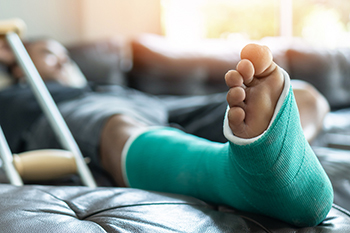Connect With Us
Blog
Items filtered by date: September 2023
Types of Bone Fractures

When it comes to foot injuries, understanding the types of broken bones in the foot is essential for effective diagnosis and treatment. Each foot contains 23 bones that may sustain an injury. A closed, or simple, fracture involves a break in the bone without piercing the skin. An open, or compound, fracture is more severe, where the bone breaks through the skin or is exposed due to a wound. This requires immediate medical attention due to the risk of infection. Greenstick fractures are commonly seen in children. These involve small, slender cracks in bones, as children's bones are more flexible. Hairline fractures, often called stress fractures, result from repetitive stress, particularly in activities like jogging or running. These tiny cracks frequently may occur in the long bones of the foot. Complicated fractures entail injuries to surrounding structures, such as veins, arteries, nerves, and the bone's lining, which may call for careful assessment and treatment. Comminuted fractures shatter the bone into small pieces, resulting in a slower healing process and requiring extensive care. Avulsion fractures occur when powerful muscle contractions pull pieces of bone where muscles attach to bones via tendons.
A broken foot requires immediate medical attention and treatment. If you need your feet checked, contact one of our podiatrists from Podiatry Care Specialists. Our doctors can provide the care you need to keep you pain-free and on your feet.
Broken Foot Causes, Symptoms, and Treatment
A broken foot is caused by one of the bones in the foot typically breaking when bended, crushed, or stretched beyond its natural capabilities. Usually the location of the fracture indicates how the break occurred, whether it was through an object, fall, or any other type of injury.
Common Symptoms of Broken Feet:
- Bruising
- Pain
- Redness
- Swelling
- Blue in color
- Numbness
- Cold
- Misshapen
- Cuts
- Deformities
Those that suspect they have a broken foot shoot seek urgent medical attention where a medical professional could diagnose the severity.
Treatment for broken bones varies depending on the cause, severity and location. Some will require the use of splints, casts or crutches while others could even involve surgery to repair the broken bones. Personal care includes the use of ice and keeping the foot stabilized and elevated.
If you have any questions please feel free to contact our offices located in West Chester, and Broomall, PA . We offer the newest diagnostic and treatment technologies for all your foot and ankle needs.
Causes of Running Injuries

Running is thought to be a good way to stay fit and healthy, but it also comes with risks. Foot and ankle injuries are all too common among runners. Overuse is a prevalent issue, usually stemming from pushing your body too hard or increasing your mileage too quickly. These actions can lead to problems like plantar fasciitis, Achilles tendonitis, and stress fractures. Poor footwear choices also play a significant role in causing foot or ankle injuries. Worn-out or ill-fitting shoes fail to provide the necessary support and cushioning, increasing the risk of injuries. Ensuring your shoes are the right fit for your feet and running style is important. Inadequate warm-up routines can strain the muscles and ligaments, making them more susceptible to injuries. In addition, running on uneven terrain can increase the likelihood of twisting an ankle. Biomechanical issues, such as overpronation or supination, can place extra stress on your feet and ankles, making them prone to injury. If you experience persistent pain or discomfort as a result of your running activity, it is suggested that you consult a podiatrist for an exam, diagnosis, and treatment options.
Exercising your feet regularly with the proper foot wear is a great way to prevent injuries. If you have any concerns about your feet, contact one of our podiatrists of Podiatry Care Specialists. Our doctors will treat your foot and ankle needs.
How to Prevent Running Injuries
Many common running injuries are caused by overuse and overtraining. When the back of the kneecap starts wearing out and starts causing pain in your knee, this is commonly referred to as runner’s knee. Runner’s knee is a decrease in strength in your quadriceps and can occur if you’re not wearing properly fitted or supporting shoes. To prevent runner’s knee, focusing on hip strengthening is a good idea, as well as strengthening your quads to keep the kneecaps aligned.
What Are Some Causes of Running Injuries?
- One cause of a common running injury is called iliotibial band syndrome.
- Plantar fasciitis is also another common injury.
- Stress fractures can occur from overtraining, lack of calcium, or even your running style.
Best Ways to Prevent Running Injuries
- Wear footwear that fits properly and suits your running needs.
- Running shoes are the only protective gear that runners have to safeguard them from injury.
- Make a training schedule. Adding strengthening exercises as well as regular stretching can help keep you strong and limber and can lessen the possibility of injuries.
- Stretching keeps muscles limber; this will help you gain better flexibility.
If you have any questions please feel free to contact our offices located in West Chester, and Broomall, PA . We offer the newest diagnostic and treatment technologies for all your foot and ankle needs.
Rugby and Foot Injuries

In the world of rugby, players frequently grapple with the physical demands of their sport, including that associated with tackles and rapid bursts of running. These actions place immense strain on the feet and ankles, crucial for balance and propulsion in scrums or while evading tackles. Proper form is paramount, especially when deadlifting and squatting. In junior and adolescent rugby, common foot related issues include Osgood-Schlatter's and Sinding-Larsen-Johansson syndrome, which cause knee pain, as well as Sever's disease, leading to heel discomfort. Shin splints and ankle sprains are also prevalent. Senior rugby players encounter additional concerns such as forefoot pain, calf and hamstring tears, and conditions that can include plantar fasciitis and Achilles tendon pain. Preventing and treating these issues involves assessments, tailored treatments, and analyzing movement patterns. It is also beneficial to address structural problems, and incorporate strength programs and balance training. Treatments range from strapping and having footwear assessments to orthotics and advanced rehabilitation techniques. If you or your child plays rugby, and especially if either one of you has endured a foot or ankle injury, it is suggested that you make an appointment with a podiatrist for further advice and necessary treatment.
Ankle and foot injuries are common among athletes and in many sports. They can be caused by several problems and may be potentially serious. If you are feeling pain or think you were injured in a sporting event or when exercising, consult with one of our podiatrists from Podiatry Care Specialists. Our doctors will assess your condition and provide you with quality foot and ankle treatment.
Common Injuries
The most common injuries that occur in sporting activities include:
- Achilles Tendonitis
- Achilles Tendon Rupture
- Ankle Sprains
- Broken Foot
- Plantar Fasciitis
- Stress Fractures
- Turf Toe
Symptoms
Symptoms vary depending upon the injury and in some cases, there may be no symptoms at all. However, in most cases, some form of symptom is experienced. Pain, aching, burning, bruising, tenderness, tightness or stiffness, sensation loss, difficulty moving, and swelling are the most common symptoms.
Treatment
Just as symptoms vary depending upon the injury, so do treatment options. A common treatment method is known as the RICE method. This method involves rest, applying ice, compression and elevating the afflicted foot or ankle. If the injury appears to be more serious, surgery might be required, such as arthroscopic or reconstructive surgery. Lastly, rehabilitation or therapy might be needed to gain full functionality in the afflicted area. Any discomfort experienced by an athlete must be evaluated by a licensed, reputable medical professional.
If you have any questions, please feel free to contact our offices located in West Chester, and Broomall, PA . We offer the newest diagnostic and treatment technologies for all your foot care needs.
We Can Treat Your Foot or Ankle Pain
We Can Treat Your Foot or Ankle Pain
Reasons to See a Podiatrist

Foot and ankle issues, from various causes like chronic conditions or ill-fitting shoes, can interfere with daily life. Consulting a podiatrist is important for conditions like joint pain, often accompanied by swelling, redness, stiffness, or tenderness, which could be due to arthritis. Diabetes increases the risk of foot problems, from dry skin to severe complications like neuropathy, and regular podiatrist foot exams significantly lower amputation risks. Persistent heel pain caused by things like heel spurs or inflamed tendons requires a podiatrist's diagnosis and tailored treatment. Stubborn ingrown toenails, a common issue, may lead to infection and a podiatrist can provide timely treatment, including nail removal in chronic cases. Suspected foot or ankle injuries, such as sprains or strains, demand prompt diagnosis and treatment. Corns and calluses, if left untreated, can be painful and a podiatrist can safely remove them and offer prevention advice. Runners prone to issues like shin splints benefit from a podiatrist's assessment and recommendations for suitable athletic footwear. Painful bunions worsen without treatment, and a podiatrist can suggest measures like padding, taping, or orthotics. Suspected athlete's foot, a fungal infection causing itchiness and scaliness between the toes, requires professional care if over-the-counter treatments do not work. If you have any sort of foot or ankle problems, it is suggested that you make an appointment with a podiatrist who can address these concerns, and offer diagnosis, treatment, and preventative guidance to enhance mobility and well-being.
If you are experiencing pain in the feet or ankles, don’t join the stubborn majority refusing treatment. Feel free to contact one of our podiatrists from Podiatry Care Specialists. Our doctors can provide the care you need to keep you pain-free and on your feet.
What Is a Podiatrist?
Someone would seek the care of a podiatrist if they have suffered a foot injury or have common foot ailments such as heal spurs, bunions, arch problems, deformities, ingrown toenails, corns, foot and ankle problems, etc.
Podiatric Treatment
A podiatrist will treat the problematic areas of the feet, ankle or lower leg by prescribing the following:
- Physical therapy
- Drugs
- Orthotic inserts or soles
- Surgery on lower extremity fractures
A common podiatric procedure a podiatrist will use is a scanner or force plate which will allow the podiatrist to know the designs of orthotics. Patients are then told to follow a series of tasks to complete the treatment. The computer will scan the foot a see which areas show weight distribution and pressure points. The podiatrist will read the analysis and then determine which treatment plans are available.
If you have any questions please feel free to contact our offices located in West Chester, and Broomall, PA . We offer the newest diagnostic and treatment technologies for all your foot and ankle needs.

